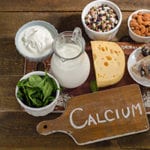
5 Steps You Can Take to Prevent Osteoporosis
Literally meaning “porous bones,” osteoporosis is a type of bone loss. The condition is very common, and some individuals are at an increased risk of developing the condition because of low bone mass (osteopenia). Some people believe osteoporosis is a normal part of the aging process, However, the condition can be managed, and even prevented in some cases, if the right precautions are taken.
1. Choose Foods Good for Your Bones
Bones need important nutrients like calcium and vitamins, C, D and K to stay strong. Low-fat dairy products, fish such as salmon and tuna, white beans, and tofu are some reliable sources of calcium. Vitamin C is found in abundance in oranges, peppers, and Brussels sprouts. Include collard greens and kale in your diet to get more vitamin K. Vitamin D can be found in greater amounts in oysters, egg yolks, some types of mushrooms, and foods fortified with vitamin D like milk, orange juice, and some cereals.
2. Stop Smoking
Women who smoke tend to produce less estrogen than women who don’t smoke, which can increase the odds of being affected by age-related bone loss. There’s also research suggesting that chemicals in cigarette smoke make it more difficult for nutrients to get to tissues in bones and joints.
3. Watch Soda and Alcohol Consumption
People who consume greater amounts of alcohol also have higher levels of the so-called “stress hormone” cortisol, which can slow down bone formation and speed up bone tissue breakdown. Excessive drinking can also boost production of the parathyroid hormone, which takes calcium away from bones. There’s also research suggesting consuming too much soda can affect bone density.
4. Keep Body Weight In Check
There’s evidence suggesting a relationship between excess body weight and osteoporosis. Extra weight increases pressure on bones, in turn boosting the risk of experiencing fractures and other issues linked to weakened or stressed bones. Being too thin can also increase the risk of developing osteoporosis.
5. Get Regular Exercise
Weight-bearing exercises like walking help bones stay strong by increasing cell production and tissue formation. Aerobics and muscle-strengthening exercises that focus on core muscle groups are among the forms of exercise that can keep bones healthy and strong. If you have underlying health issues that make certain exercises difficult, water-based exercises can produce similar results.
People generally reach peak bone mass between 25 and 30 years of age. A natural loss of bone mass typically begins after the age of forty. Changes women experience due to menopause sometimes increase the risk of developing osteoporosis. While the steps mentioned here can help prevent degenerative arthritis, uncontrollable factors such as gender, ethnicity, and body size also play a role in how the condition affects people. Another important step that can be taken is to have a bone density test, especially if you have a family history of osteoporosis or if some of the risk factors commonly associated with arthritis apply to you.






